 Sights Sights
 Medieval Remnants Medieval Remnants
 Prussian Glory Prussian Glory
 Nation to Republic Nation to Republic
 Nazi Germany Nazi Germany
 Divided City Divided City
 Modern Capital Modern Capital
 Tours Tours

|
The Berlin Wall
Photo © Heiko Burkhardt.
 Think of Berlin and you think of the Wall. For 28 years Berlin existed as two cities, the physical symbol of the dislocation between the capitalist West and the communist East. Although many of the social and psychological scars have yet to be fully healed, the physical evidence of the division of the city is becoming increasingly harder to find. In many areas, the only reminder of the wall's presence is a row of red cobblestones which run the length of the former perimeter. Actual sections of the wall can still be seen at several locations, the longest being at the East Side Gallery , which runs between Ostbahnhof and Warschauer Straße. Much more obviously a victim of souvenir hunters is the section alongside the Topography of Terror exhibition on Niederkirchnerstraße. A complete section of wall and accompanying border defences forms the Memorial of German Separation , which also has a very good Documentation Centre with heaps of information about the history of the wall. A more emotional and tourist-oriented view of wall history is on display at Checkpoint Charlie , which also has a couple of token wall segments. For a complete listing of wall locations and plenty of interesting facts, photos and historical information, check out the Wall website . Think of Berlin and you think of the Wall. For 28 years Berlin existed as two cities, the physical symbol of the dislocation between the capitalist West and the communist East. Although many of the social and psychological scars have yet to be fully healed, the physical evidence of the division of the city is becoming increasingly harder to find. In many areas, the only reminder of the wall's presence is a row of red cobblestones which run the length of the former perimeter. Actual sections of the wall can still be seen at several locations, the longest being at the East Side Gallery , which runs between Ostbahnhof and Warschauer Straße. Much more obviously a victim of souvenir hunters is the section alongside the Topography of Terror exhibition on Niederkirchnerstraße. A complete section of wall and accompanying border defences forms the Memorial of German Separation , which also has a very good Documentation Centre with heaps of information about the history of the wall. A more emotional and tourist-oriented view of wall history is on display at Checkpoint Charlie , which also has a couple of token wall segments. For a complete listing of wall locations and plenty of interesting facts, photos and historical information, check out the Wall website .
|
East Side Gallery
www.east-side-gallery.com
Mühlenstr. , 10243 Berlin - Friedrichshain | S Ostbahnhof/S + U Warschauer Straße | Price: Free. | Times: 24 hours a day.
map:
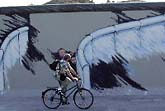 At over a kilometre in length, this is the longest section of wall still standing, and possibly also the longest gallery in the world. Originally painted by over 100 German and international artists shortly after reunification, the harsh Berlin weather and a growing amount of grafitti have taken their toll over the past ten years. Luckily, funding has been made available for the repainting of the gallery, which is currently in progress. Many of the panels have political themes, which have been preserved in the new incarnation. At over a kilometre in length, this is the longest section of wall still standing, and possibly also the longest gallery in the world. Originally painted by over 100 German and international artists shortly after reunification, the harsh Berlin weather and a growing amount of grafitti have taken their toll over the past ten years. Luckily, funding has been made available for the repainting of the gallery, which is currently in progress. Many of the panels have political themes, which have been preserved in the new incarnation.
|
Soviet War Memorial - Treptower Park
Treptower Park , 12435 Berlin - Treptow | S Bhf Treptower Park, Bus 265 | Price: Free.
map:
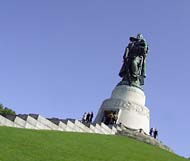 In the heart of Treptower Park lies the Soviet Union's memorial to its fallen heroes of war. Situated on the site of the workers strike of 1919 led by the revolutionary luminaries of Karl Liebknecht and Rosa Luxembourg, the monument is more of an arena of remembrance than one specific statue. The first part of the memorial is a granite statue of Mother Russia grieving for her lost children. A vast concourse slopes up to a viewing platform which is flanked by two huge triangles of red granite, reportedly taken from Hitler's New Chancellory, each accompanied by statues of kneeling soldiers. From this point, the memorial opens out across a sunken plaza, where 5000 Soviets corpses from the Battle of Berlin are buried, flanked by 16 sarcophagi representing the then 16 Soviets states, each inscribed with quotes from Stalin. On high, overlooking the plaza, is a 13m high statue of a Russian holding a child while his sword rests on a broken swastika. Inside the base of the statue is a small memorial crypt with mosaic walls depicting a scene of workers, peasants and Asian minorities, all presumably thankful for being rid of the tyranny of National Socialism. This is highly thought-provoking landscape gardening on a big scale and all without a single piece of religious symbolism. In the heart of Treptower Park lies the Soviet Union's memorial to its fallen heroes of war. Situated on the site of the workers strike of 1919 led by the revolutionary luminaries of Karl Liebknecht and Rosa Luxembourg, the monument is more of an arena of remembrance than one specific statue. The first part of the memorial is a granite statue of Mother Russia grieving for her lost children. A vast concourse slopes up to a viewing platform which is flanked by two huge triangles of red granite, reportedly taken from Hitler's New Chancellory, each accompanied by statues of kneeling soldiers. From this point, the memorial opens out across a sunken plaza, where 5000 Soviets corpses from the Battle of Berlin are buried, flanked by 16 sarcophagi representing the then 16 Soviets states, each inscribed with quotes from Stalin. On high, overlooking the plaza, is a 13m high statue of a Russian holding a child while his sword rests on a broken swastika. Inside the base of the statue is a small memorial crypt with mosaic walls depicting a scene of workers, peasants and Asian minorities, all presumably thankful for being rid of the tyranny of National Socialism. This is highly thought-provoking landscape gardening on a big scale and all without a single piece of religious symbolism.
|
Alexander Platz
Alexanderplatz , 10178 Berlin - Mitte | S+U Alexanderplatz |
map:
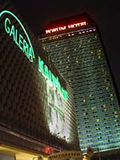 As the GDR's interpretation of a modern city centre, Alexanderplatz acts as an indelible reminder of what different tracks the two Germanys were on. Originally a bustling traffic and business centre, the area was nearly totally destroyed during the war leaving restless communist hands a blank canvas on which to express themselves. Two pre-war buildings still remain on the platz: the Berolinahaus and the Alexanderhaus, both designed by Peter Behrens in the early 30's. The nasty looking water feature in the centre of the square goes by the name of "Brunnen der Völkerfreundschaft" which, loosely translated allowing for questionable socialist concepts, means "Fountain of Friendship of Peoples". Ironically or not, it used to be a gathering point for prostitutes. In the same taste-bracket as the fountain is the nearby Weltzeituhr (World Clock) which defies description but, nevertheless, tells the time in various different cities around the world. On the north east edge of the platz is the mesmerisingly metalic Kaufhof department store which, although very well stocked in socialist days, is now relatively run of the mill. The tall and ugly Forum Hotel overlooks the square from the north east side but the whole lot is dwarfed by the Fernsehturm which towers up from the other side of Bahnhof Alexanderplatz. The whole spectacle should be viewed during the day in order in appreciate the architecture and vast spaces involved, but also at night so as to experience the new capitalist additions of flashing advertisements and a giant TV screen. It was, fittingly, on Alexanderplatz that the demonstration of 4th November 1989 was concentrated. This was, in effect, the first act in a chain of events which lead to the fall of the Wall on the 9th. As the GDR's interpretation of a modern city centre, Alexanderplatz acts as an indelible reminder of what different tracks the two Germanys were on. Originally a bustling traffic and business centre, the area was nearly totally destroyed during the war leaving restless communist hands a blank canvas on which to express themselves. Two pre-war buildings still remain on the platz: the Berolinahaus and the Alexanderhaus, both designed by Peter Behrens in the early 30's. The nasty looking water feature in the centre of the square goes by the name of "Brunnen der Völkerfreundschaft" which, loosely translated allowing for questionable socialist concepts, means "Fountain of Friendship of Peoples". Ironically or not, it used to be a gathering point for prostitutes. In the same taste-bracket as the fountain is the nearby Weltzeituhr (World Clock) which defies description but, nevertheless, tells the time in various different cities around the world. On the north east edge of the platz is the mesmerisingly metalic Kaufhof department store which, although very well stocked in socialist days, is now relatively run of the mill. The tall and ugly Forum Hotel overlooks the square from the north east side but the whole lot is dwarfed by the Fernsehturm which towers up from the other side of Bahnhof Alexanderplatz. The whole spectacle should be viewed during the day in order in appreciate the architecture and vast spaces involved, but also at night so as to experience the new capitalist additions of flashing advertisements and a giant TV screen. It was, fittingly, on Alexanderplatz that the demonstration of 4th November 1989 was concentrated. This was, in effect, the first act in a chain of events which lead to the fall of the Wall on the 9th.
|
The Karl Marx (formerly Stalin) Allee
Karl Marx Allee ,
map:
Conceived in 1950 as a showpiece for East Germany, (and as a 70th birthday present for Joe Stalin), the Karl Marx Allee stands as a symbol for the fate of the German Democratic Republic. Work on the 90 metre wide east-west drag was commenced in the heady early years of the Republic and was laid out on a grand scale. The apartments and shops lining the street are of generous proportions and were (relatively) luxuriously fitted out. Several kilometres, years of building and fortunes later, Moscow called off all further work on the project - it seems that until then the East German state couldn't bring itself to admit that the idea was financial folly. Over the years, the buildings didn't weather at all well - the Russian-style ceramic cladding had a nasty habit of falling off, and when the gaps were eventually filled, fake tiles were used. Over time, the plastic replacement tiles became hideously discoloured. These brownish tiles can still be seen on the unrenovated part of the street (where the Karl Marx Allee becomes the Frankfurter Allee). The irony is that the whole thing is now owned by a western bank, which is gradually renovating it and renting it out to well-to-do westerners.
|
Television Tower
(Fernsehturm)
www.berlinerfernsehturm.deinfo@berlinerfernsehturm.de
Alexanderplatz , 10178 Berlin - Mitte | Tel: 242 3333, Fax: 242 5922 | S+U Alexanderplatz, Bus 100, 142, 157, 257 | Times: Panoramaetage (viewing deck): Mar - Oct 9:00 - 1:00; Nov - Feb 10:00 - 24:00 | Admission: € 12, concessions € 6
map:
 Visible from almost every location in the city, Berlin's Television Tower, at a height of 368 metres, is the third-tallest building in Europe. It was built in the late 1960s as a symbol of the modernity of communist East Germany. Ironically though the construction was beyond the capacity of East German engineers and Swedish expertise was required to build the tower. Looming over the Alexanderplatz, the TV Tower offers by far the best view of Berlin, and in good weather you can see up to as far as 40 km. When the sun shines on the tower the reflection in the silver ball at the top forms the shape of a cross. This was a point of amusement to the residents of officially atheist East Germany; they dubbed the tower the "Pope's Revenge." Visible from almost every location in the city, Berlin's Television Tower, at a height of 368 metres, is the third-tallest building in Europe. It was built in the late 1960s as a symbol of the modernity of communist East Germany. Ironically though the construction was beyond the capacity of East German engineers and Swedish expertise was required to build the tower. Looming over the Alexanderplatz, the TV Tower offers by far the best view of Berlin, and in good weather you can see up to as far as 40 km. When the sun shines on the tower the reflection in the silver ball at the top forms the shape of a cross. This was a point of amusement to the residents of officially atheist East Germany; they dubbed the tower the "Pope's Revenge."
In the revolving Telecafe, at a height of 207m (and with prices almost as high), you can drink a cup of coffee in the time it takes to go 360 degrees. Children (and adults alike), prepare to be disappointed by the slow revolution time.
|
Airlift Memorial (Luftbrückendenkmal)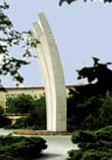
Platz der Luftbrücke 1, 12101 Berlin - Tempelhof | U6 Platz der Luftbrücke |
map:
Reportedly known by some Berliners as Hungerharke (Hunger Rake), the Luftbrückendenkmal stands outside the airport in a small park type area. Designed by Professor Eduard Ludwig, it represents the three air corridors used to fly in supplies to during the Berlin Airlift. The monument itself forms a half-bridge shape "joined by air" to its other half in Frankfurt. On its plinth are the names of the 78 crew and groundstaff who died during the 328 days in 1948-49 during which West Berlin (cut off from the outside world) was suplied by allied air-transport. A smaller version of the memorials in Berlin and Frankfurt can be found at Celle Airport in Lower Saxony and although they all commemorate a very significant event in the Cold War, the world would have been a prettier place with just the one.
|
Memorial of German Separation (Gedenkstätte Berliner Mauer)
Bernauer Str , 13355 Berlin - Wedding | Tel: 464 10 30, Fax: 464 4755 | U8 Bernauer Straße | Price: Free. | Times: (Documentation Centre) Wed-Sun 10-17. | Tours can be arranged by faxing the centre beforehand. | Photo © Heiko Burkhardt.
map:
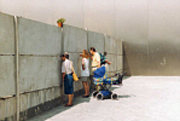 After the fall of the wall the authorities acquired this section as a memorial to those who suffered under communism. Complete with border defences and "death strip", it is carefully protected from tourist hammers and local grafitti artists and is probably one of the best places to view the wall as it used to be. Across the road at Bernauer Str. 111 is the Berlin Wall Documentation Centre (Dokumentationszentrum Berliner Mauer), which has extensive displays and information about the history of the wall. The neighbouring Church of Reconciliation (Kapelle der Versöhnung) is built in no-man's land on the site of a church destroyed during the building of the wall and acts as a memorial to all those who died trying to escape the communist regime. After the fall of the wall the authorities acquired this section as a memorial to those who suffered under communism. Complete with border defences and "death strip", it is carefully protected from tourist hammers and local grafitti artists and is probably one of the best places to view the wall as it used to be. Across the road at Bernauer Str. 111 is the Berlin Wall Documentation Centre (Dokumentationszentrum Berliner Mauer), which has extensive displays and information about the history of the wall. The neighbouring Church of Reconciliation (Kapelle der Versöhnung) is built in no-man's land on the site of a church destroyed during the building of the wall and acts as a memorial to all those who died trying to escape the communist regime.
|

 top of page top of page
 ©
1999-2011 Berlin Information Group ©
1999-2011 Berlin Information Group anything missing or wrong? anything missing or wrong?
|

|

